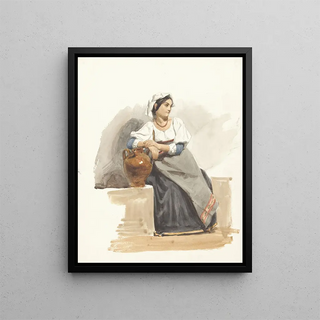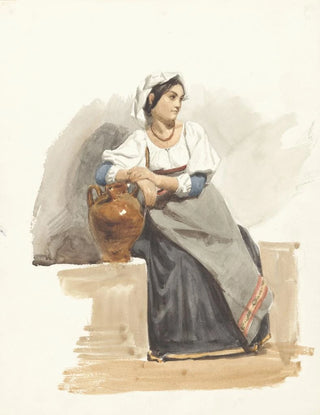Art print | Costume study of an Italian girl - Pierre Louis Dubourcq


View from behind

Frame (optional)
In the vast panorama of art history, certain works stand out for their ability to capture the essence of an era, a culture, or an emotion. The art print of Study of a young Italian girl's costume - Pierre Louis Dubourcq is one of those pieces that, through its elegance and finesse, transports the viewer to the heart of 19th-century Italy. This painting, far from being a simple representation, is a true invitation to explore the clothing traditions and the subtleties of the customs of that time. By contemplating this work, one immerses oneself in an atmosphere where art and culture meet, thus revealing the intrinsic beauty of the Italian female costume.
Style and uniqueness of the work
Pierre Louis Dubourcq's work is characterized by meticulous attention to detail and a palette of delicate colors that evoke the softness of Italian light. The young girl posing for the artist is dressed in a traditional costume, carefully rendered, which testifies to the authenticity and richness of the textiles of the period. The drapes, floral motifs, and ornaments are depicted with such precision that they seem almost tangible. Dubourcq does not merely reproduce a garment; he captures the spirit of a culture, the elegance of an carefree youth, and the beauty of traditions that shape Italian identity. Each brushstroke demonstrates exceptional craftsmanship and artistic sensitivity, making this work a true masterpiece.
The artist and his influence
Pierre Louis Dubourcq, a French artist of the 19th century, established himself as a master in the field of costume art print. His career is marked by a fascination with traditional clothing, which he explored through numerous portraits and studies. Far from being a mere observer, Dubourcq immersed himself in the cultures he depicted, seeking to understand and convey the deep meanings behind each fabric and color. His influence is felt not only in the art world but also in fashion and ethnology, where his work is often cited as a reference.

Matte finish

View from behind

Frame (optional)
In the vast panorama of art history, certain works stand out for their ability to capture the essence of an era, a culture, or an emotion. The art print of Study of a young Italian girl's costume - Pierre Louis Dubourcq is one of those pieces that, through its elegance and finesse, transports the viewer to the heart of 19th-century Italy. This painting, far from being a simple representation, is a true invitation to explore the clothing traditions and the subtleties of the customs of that time. By contemplating this work, one immerses oneself in an atmosphere where art and culture meet, thus revealing the intrinsic beauty of the Italian female costume.
Style and uniqueness of the work
Pierre Louis Dubourcq's work is characterized by meticulous attention to detail and a palette of delicate colors that evoke the softness of Italian light. The young girl posing for the artist is dressed in a traditional costume, carefully rendered, which testifies to the authenticity and richness of the textiles of the period. The drapes, floral motifs, and ornaments are depicted with such precision that they seem almost tangible. Dubourcq does not merely reproduce a garment; he captures the spirit of a culture, the elegance of an carefree youth, and the beauty of traditions that shape Italian identity. Each brushstroke demonstrates exceptional craftsmanship and artistic sensitivity, making this work a true masterpiece.
The artist and his influence
Pierre Louis Dubourcq, a French artist of the 19th century, established himself as a master in the field of costume art print. His career is marked by a fascination with traditional clothing, which he explored through numerous portraits and studies. Far from being a mere observer, Dubourcq immersed himself in the cultures he depicted, seeking to understand and convey the deep meanings behind each fabric and color. His influence is felt not only in the art world but also in fashion and ethnology, where his work is often cited as a reference.






